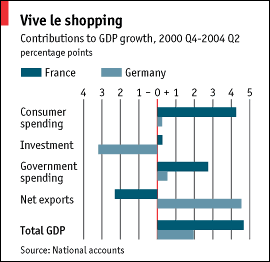Last week I mentioned some recent history behind the Germany-France economic relationship that is the core of euro economics. The event I mentioned was from 2010 when the French finance minister of the time, Christine Lagarde, made reference to the growing imbalances within the Eurozone caused by the differential between French and German macroeconomic policy:
“(Could) those with surpluses do a little something? It takes two to tango,” she told the Financial Times newspaper. “Clearly Germany has done an awfully good job in the last 10 years or so, improving competitiveness, putting very high pressure on its labour costs.”
“I’m not sure it is a sustainable model for the long term and for the whole of the group,” she said. “Clearly we need better convergence.”
Interestingly, however, this is a one sided view of the issue. If you wind the clock back to 2004 and look at an Economist article written at that time you get a very different story:
Since the middle of 2003, the euro area’s economies have grown at their fastest for more than three years. Even so, the 2% average increase in their real GDPs in the past year is less than half that of America or Japan. Moreover, too much of Europe’s growth has come from foreign demand: real domestic demand (consumer spending, investment and government expenditure) grew at an annual rate of only 1.2%. Indeed, in the second quarter, net exports explained almost all the growth in GDP. America has good reason to complain that Europe is not pulling its weight in the world economy.
Meanwhile, America’s domestic demand has surged by 5% in the past year. The huge gap between this and the feeble expansion in the euro area partly explains why America’s current-account deficit widened to almost 6% of GDP in the second quarter. The gulf between American and European economic performance is often blamed on the old continent’s less flexible labour and product markets, but over the past couple of years America’s super-loose fiscal and monetary policies have surely been more important. That stimulus is now fading, so the growth gap between Europe and America is likely to narrow over the next year.
However, aggregate figures for the euro area mask big differences among countries, not least between the two largest: while Germany’s GDP grew by only 1.5% in the past year, France managed 3%. Leave aside Germany, and domestic demand for the whole zone looks much healthier: up 2.5% in the past year. Both France and Spain enjoyed increases of around 4%. In Germany, domestic demand fell by 0.7%.
Back in the early naughties the fact that Germany suppressed its wage growth and was also managing down local credit expansion was seen as a negative. France, like periphery nations, on the other hand were expanding their economies via credit and therefore running, or beginning to run, trade deficits. The difference in policy is quite obvious from the charts below.
Compare France, which has transformed its economy in the last 7 years into one driven by private sector credit expansion.
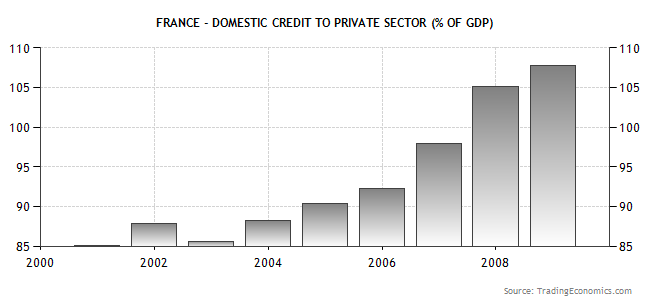
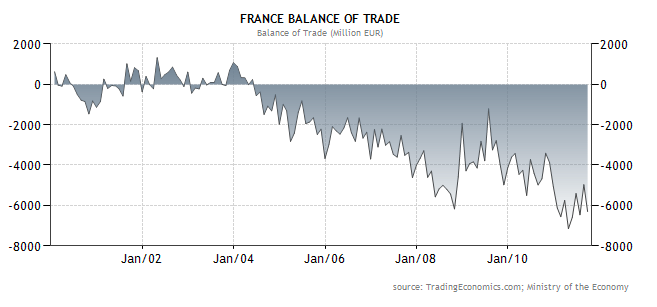
To Germany, which has relied on export strength to create growth while the private sector has deleveraged:
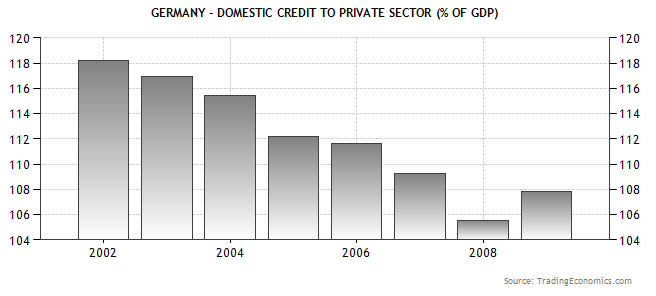
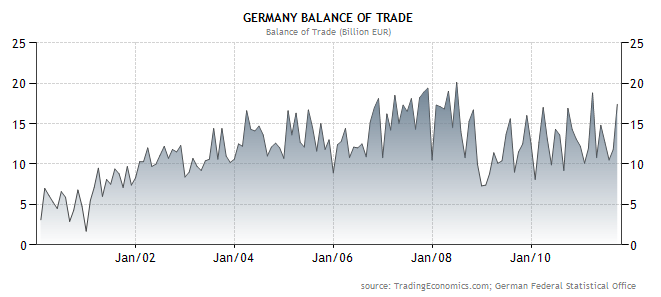
Again from 2004:
The difference in the performances of the Euro giants has two important implications. First, if the economies of America and China slow sharply over the next year, Germany’s economy will be much more vulnerable than France’s. Germany needs to find more growth at home. Second, the monetary policy of the European Central Bank (ECB), which sets a single interest rate for the whole euro area, is currently probably not ideal for either economy.
Consumer spending has been stronger in France partly because jobs and hence incomes have been growing faster there than in Germany, but also because since the end of 2000 France’s household-saving rate has fallen from 17% to 14.5% of disposable income, while Germany’s has risen from 9.6% to 10.9%. This may reflect German households’ angst over economic reforms. Unemployment benefits are to be cut sharply from January, adding to worries about the consequences of losing a job. Meanwhile, several big German firms have reached deals with workers to cut costs by working longer hours for the same pay. In the long term, this should lift profits and investment, increase Germany’s growth rate, and so boost incomes and jobs, but in the short term it is dampening consumer confidence.
That “risk” obviously paid off, especially in later years when the emerging middle classes of China and other BRICS took a liking to German manufacturers. However, within Europe the outcome of this policy was two-fold, firstly Germany’s competitiveness against its euro counterparts grew and, secondly, German companies were forced to seek external customers for their goods because German consumers did not provide that demand. That is, in part, Germany required deficits in other parts of Europe to support its export driven growth.
Under a common currency this was always going create growing imbalances that would, if left unchecked, eventually lead to stability problems for Europe. However, this wasn’t the major cause of the current crisis, it was more of a fuse than the bomb itself. The major issue was that the new Eurozone distorted the risk profile of each country towards the core and the banking system and the markets were therefore completely imprudent about accessing the real risk of capital allocation. Lending became based on a single supra-European risk profile which led to the cheap and unmanaged flow of credit. This credit flow mixed with the ECB’s “core-focussed” interest rate settings created bubbles across Europe in property, government bonds, goods and services far above what the real economies of the underlying countries could ever service. This resulted in large and unserviceable debts and current accounts as they increasingly diverged from competitiveness of the countries that held them.
But back in 2004 it wasn’t seen that way:
Perhaps another reason why consumer spending has boomed in France and stagnated in Germany is that average house prices have risen by 14.5% in France over the past year, but fallen by 1.7% in Germany. Indeed, over the past three years prices have fallen in Germany, but climbed by almost 40% in France.
Residential-property prices are also rising briskly in Spain, Ireland, Italy and Belgium. A house-price boom can support consumer spending by making households feel wealthier. Indeed, in the euro area there has been a close relationship over the past year between house-price inflation and the strength of consumer spending: in countries with large house-price gains, such as France and Spain, people have increased spending fastest; in countries with flat or falling property prices, notably Germany and the Netherlands, they have been spending less.
Credit drove houses, houses drove consumerism which means imported goods. It all sounds so familiar doesn’t it? It also makes you realise the disconnect between GDP growth and economic stability and, as we are now fully aware, it all ended horribly. Germany didn’t have a housing bubble of it’s own but, as I stated above, German companies were forced to seek external markets in order to support their profits and that included banks:
[German] banks bought heavily into the structured financial products (A.B.S.‘s, R.M.B.S.‘s,C.D.O.‘s and the rest of the alphabet soup) derived from bad property loans that are at the heart of the crisis. That story has not yet run its course: The “bad banks” that the Germans set up to wind down those investments are going to be, so to speak, very, very bad.
A little bit of modern history puts some context around what we are seeing in Europe. If you break down the last decade in European economics you realise that it is just another asset bubble caused by a lack of risk management and capital misallocation. This time on a grand-scale.
The debate that is raging in Europe right now is about how and who is going to pay the bill. France needs inflation, while the Germans are pushing for deflationary policy. It is no wonder they can’t see eye-to-eye.
